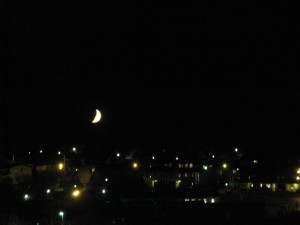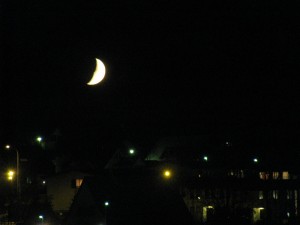The heartbroken girl who became a legend. Posted by hulda on Oct 23, 2012 in Icelandic culture, Icelandic history
 As far as obsessive love that goes on to death and beyond, the Djákninn á myrká isn’t actually even close to being the worst of his kind. The crown of Iceland’s most horrifying ghost goes instead to a young lady called Solveig, who used to live in a place called Míklabæ, giving the name to the story of Míklabæjar-Solveig.
As far as obsessive love that goes on to death and beyond, the Djákninn á myrká isn’t actually even close to being the worst of his kind. The crown of Iceland’s most horrifying ghost goes instead to a young lady called Solveig, who used to live in a place called Míklabæ, giving the name to the story of Míklabæjar-Solveig.
“Stúlka ein er Solveig hét var hjá síra Oddi Gíslasyni á Miklabæ. Hvort sem prestur hefur þá verið milli kvenna eða verið búinn að missa konu sína er óvíst, en hitt er víst að stúlka þessi lagðist á hugi við prest og vildi umfram allt að hann ætti sig en prestur vildi ekki.”
“A girl named Solveig lived in Míklabæ at Rev. Oddur Gíslason’s.* Whether the priest had then been single** or a widow is not known, but that is known that this girl set her mind on him and wanted more than anything that he’d marry her, but the priest did not want to.”
So begins the story. After being denied by the priest Solveig became severely depressed and began to attempt suicide. Eventually she was put under a constant watch until one fateful night she managed to run away and slit her throat. As her last words she begged the priest that he’d let her be buried in holy ground.
Oddur sought permission to bury her, but this was strictly denied because Solveig had killed herself and was therefore not allowed to rest in the churchyard. The text mentions something rather sinister happening next: “á meðan þessu fór fram stóð lík Solveigar uppi” (= while this went on the body of Solveig stood up), meaning that she turned into a kind of a zombie, if you will.
The next night reverent Oddur dreamt that Solveig stood by his bed and swore that since he had not granted her her wish he would not be buried in the churchyard either. Ever since then she haunted him whenever he was alone and was so insistent that the priest had to be followed around by others to guard him.
One evening as the people at Míklabæ were waiting for the priest to return home and had already gone to bed, trusting his escorts to keep him safe, there was a loud knock at the door. Scared out of their wits*** the people did not dare to open right away.
“Síðan heyrðu þeir að komið var upp á baðstofuna í mesta snatri en áður en sá fékk rádrúm til að guða sem upp kom var hann dreginn ofan aftur eins og tekið hefði verið aftan í hann eða í fæturna á honum.”
“Next they heard someone rush in to the main room (bedrooms were usually on the second floor) but before anyone could spring into enough action to find out who it was, the person was dragged away as if he had been caught by his back or his feet.”
The next day the priest was nowhere to be found. The people who had seen him home the previous night had left him by the side of his house, thinking he was already safe. As the search proved to be unfruitful the man who had found Solveig as she lay dying swore he would not stop until he found out what had become of the priest. He collected items that had belonged to him, placed them under his pillow and asked a woman called Guðlaug to watch over his sleep.
As he slept he dreamt that Solveig walked in the room with something in her hand. She sat on his bed, told him he would never find the reverend Oddur and put a knife on his throat as if meaning to kill him. The nightmare made Þórsteinn trash around and seeing this, Guðlaug woke him up and they were both shocked to find red gashes on the man’s throat where Solveig had held her knife. All search for Oddur was therefore called to a halt and people assumed Solveig had finally got her revenge.
There the story ends, yet another one begins. Much later on, when Solveig’s grave site’s exact location had already been forgotten by all, another priest Jón Hallson found a grave somewhat removed from the main churchyard. There they found feet that they assumed to belong to a man, but the corpse was for some reason buried face down. The grave was quickly filled up again and left where it was.
But the story doesn’t quite end there either. Solveig of Míklabæ is actually not a fictional character at all. She’s mentioned in writings from her time and the story gets a bit more background to it from them. It seems that she and the priest might have had some kind of a relationship that nevertheless did not lead to marriage, instead the Reverend Oddur married another woman. Solveig went insane and killed herself 11th April 1778, ending up buried outside and her name not mentioned in the church documents – suicides were not allowed to be written there.
Eight years after that, on the 1st October 1786, the reverend Oddur disappeared without a trace. At the night of his disappearance he was being expected to return home and someone – or something – had indeed knocked on the kitchen window, but for an unmentioned reason his own son felt too afraid to open the door.
The priest did not disappear for eternity, though. In a letter that’s dated in the year 1789 Ragnheiður Þórarinsdóttir writes that the body of the priest had been found. The cause of death was deemed suicide. The Reverend himself could therefore not be buried in holy ground and all his belongings were taken away from his family and given to the crown instead, as was done in such cases. It’s been therefore speculated that at the time of his disappearance his family knew what had happened and had perhaps not really looked for him, rather they had tried to hide what had happened. Some even suggest that the legend of Solveig could actually be the result of this. As legends go it was a lively one indeed; several people have since reported seeing or even having met with Solveig, blood running down her neck and over her clothes!
Whatever the truth behind the story, it can be said for certain that a body that was suspected to be Solveig’s was eventually moved to a cemetery at Glaumbæ in 1937. Perhaps she can now finally rest in peace.
A short movie about Míklabæjar-Solveig. (In Icelandic but easy to follow.)
An article printed in 1962 discusses Solveig’s story. (In Icelandic)
One version of the legend of Míklabæjar-Solveig. (In Icelandic)
Wikipedia page on the real Solveig. (In Icelandic)
The Grapevine’s take on the story. (In English)
*By appearances two male names look like they could fit the situation, Oddi and Oddur. Yet only one of them fits: the preposition hjá demands a þagufall (= dative) form, and this is a giveaway that the priest’s name was Oddur (Oddur – Odd – Oddi – Odds), not Oddi (Oddi – Odda – Odda – Odda).
**”Milli kvenna” (= between women) can translate as both single and divorced. 😉
***You would be easily spooked too if you knew to expect a zombie attack.

Build vocabulary, practice pronunciation, and more with Transparent Language Online. Available anytime, anywhere, on any device.
About the Author: hulda
Hi, I'm Hulda, originally Finnish but now living in the suburbs of Reykjavík. I'm here to help you in any way I can if you're considering learning Icelandic. Nice to meet you!







